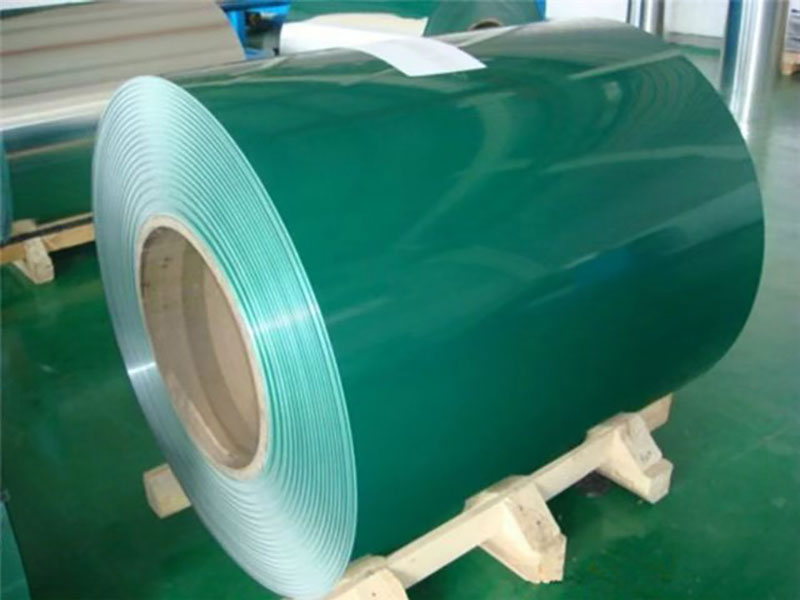
The self-cleaning aluminum-magnesium-manganese colored aluminum plate is a high-end building and industrial material that combines functionality, environmental friendliness, and decorative value. Based on an Al-Mg-Mn alloy substrate (Al-Mg-Mn system), it features a nano-scale self-cleaning coating and colored fluorocarbon spraying process. Through photocatalytic reactions and superhydrophobic effects, it achieves active cleaning capabilities, addressing the pain points of traditional metal panels’ susceptibility to pollution and maintenance challenges. It has become an ideal choice for modern green buildings, renewable energy infrastructure, and industrial equipment.
Self-Cleaning Mechanism
Photocatalytic Decomposition: The coating contains titanium dioxide (TiO₂) nanoparticles that activate under UV light, decomposing organic pollutants (e.g., NOx, VOCs) and dust into harmless CO₂, H₂O, and trace minerals.
Lotus Effect Hydrophobicity: Micro/nano-structured surfaces achieve a contact angle >150°, causing rainwater and oil stains to bead and roll off, enabling passive cleaning with minimal effort.
Alloy Substrate Optimization
Composition Control: precise Al-Mg-Mn ratios (Mg: 4-6%, Mn: 1-2%) stabilize the β-phase structure, balancing high strength (>180 MPa) and corrosion resistance (ASTM B117-19 standard for 2000+ hours).
Heat Treatment: T6 solid-solution aging eliminates internal stresses, enhancing fatigue resistance for high-vibration environments (e.g., wind turbine towers).
Surface Treatment Technology
Primer: Epoxy zinc-chromate coating for corrosion resistance and adhesion (>70 N/mm²).
Color Layer: Fluorocarbon resin + metallic pigments ensure Pantone color accuracy (<ΔE 3) and UV resistance (>2000 hours in QUV testing).
Self-Cleaning Layer: Composite TiO₂/silica nano-coating (15-30 μm thick) with >85% light transmittance.
Four-Coat, Three-Bake Process:
| Metric | Self-Cleaning Al-Mg-Mn Plate | Traditional Fluorocarbon Plate | PVC Composite Material |
|---|---|---|---|
| Self-Cleaning | Active decomposition, 10+ years maintenance cycle | Manual cleaning (3-6 month cycles) | Prone to dust adsorption |
| Corrosion Resistance | >5000 hours in salt spray test | 3000 hours with mild oxidation | 1000 hours with surface powdering |
| Strength/Weight Ratio | 180 MPa / 2.7 kg/m² | 150 MPa / 3.1 kg/m² | 60 MPa / 4.5 kg/m² |
| Carbon Emission | 40% lower production energy use | High-temperature spraying emissions | Contains CFCS (environmental hazard) |
| Light Transmittance | ≥85% (semi-transparent options) | ≤70% | 0% |
Green Building Facades
Shanghai Tower: Utilized for exterior cladding, reducing HVAC energy consumption by 30% and annual maintenance costs by >2 million CNY.
Singapore Botanic Gardens: Integrated with photovoltaic glass to control light pollution and support ecological conservation.
Renewable Energy Infrastructure
Wind Turbine Towers: Designed for desert environments (e.g., Kubuqi Gobi Wind Farm), operating flawlessly for 5 years with <0.5‰ failure rate.
PV Module Frames: Suppresses PID effect (>90%) through anti-dust coatings and conductive aluminum substrates.
Industrial & Transportation Equipment
High-Speed Railway Platforms: Hong Kong West Kowloon Station’s 25-year lifespan with no color fading after 10 years of use.
Port Crane Arms: Resist seawater impact and oil stains; maintenance frequency reduced by 60% at Qingdao Port.
Production Workflow
Melting: Vacuum melting of Al-Mg-Mn alloy ingots (purity >99.7%) → casting → T6 heat treatment.
Rolling: Cold-rolled into sheets (thickness precision ±0.05 mm) → chemical cleaning → surface pretreatment.
Coating: Electrostatic spraying primer → UV curing → precision screen printing → self-cleaning layer喷涂 → infrared curing.
International Certifications
Material Performance: ISO 12944-2 Class 5 (extreme weather durability), ASTM E312 85° gloss.
Environmental Compliance: RoHS-compliant (<0.01% heavy metals), REACH SVHC exemption.
Driven by global carbon neutrality goals, the self-cleaning Al-Mg-Mn plate is projected to reach an $8B market by 2025, with a 55% lower LCA carbon footprint than traditional materials. Future R&D focuses on:
Photovoltaic Integration: Embedding perovskite solar cells for "building-powering" synergy.
Smart Coatings: Temperature/humidity-responsive surfaces for dynamic hydrophobicity regulation (e.g., superhydrophobic in rain, hydrophilic anti-fog in sunshine).
The self-cleaning Al-Magnesium-Manganese colored aluminum plate represents a paradigm shift in material science and sustainable architecture. By synergizing "technology-enabled materials" and "ecology-driven design," it is redefining standards for modern construction and industrial applications, positioning itself as a critical player in the global pursuit of green innovation.